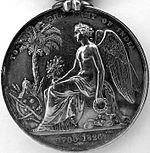| Army of India Medal | |
|---|---|
  Obverse (top left) and reverse (top right) of the medal. Ribbon: 32mm, pale blue. | |
| Awarded by United Kingdom of Great Britain and Ireland | |
| Type | Campaign medal |
| Eligibility | British and Honourable East India Company forces. |
| Awarded for | Campaign service. |
| Campaign | India 1803–26. |
| Description | Silver disk, 36mm diameter. |
| Clasps | 21 authorised. |
| Statistics | |
| Established | 21 March 1851 |
| Total awarded | 4,500 |
The Army of India Medal (AIM) was a campaign medal approved in 1851 for issue to officers and men of the British Army and the Army of the Honourable East India Company. A retrospective award following the precedent set by the Naval General Service Medal and the Military General Service Medal, it served to commemorate service in various actions from 1803-1826
Criteria[]
The Army of India Medal was approved on 21 March 1851 as a retrospective award by the Honourable East India Company to survivors of various actions during the period 1803–1826. This period encompassed four wars: the Second Mahratta War (1803–4), the Gurkha War (1814–16), the Pindaree or Third Mahratta War (1817–18), and the First Burmese War (1824–26). Each battle or action covered by the medal was represented by a clasp on the ribbon; twenty-one were sanctioned[1] (although the maximum awarded to one man was seven).[2] The medal was only awarded to survivors and, as such, there are substantially fewer medals issued when compared with the number of men who served during this period. This was largely due to the extreme lapse of time between the wars commemorated and the issue of the medal—forty-eight years had passed between the first battle commemorated —Allighur in 1803—and the date of issue, 1851. Some 4,500 medals were awarded in total—most with only a single clasp.[3]
Appearance[]
The medal is circular, made of silver, and 1.4 inches in diameter. The obverse of the medal bears an effigy of a young Queen Victoria wearing a diadem. On either side of the effigy is the inscription VICTORIA and REGINA. The reverse bears and an allegorical representation of Victory holding a laurel branch in her right hand and a wreath in her left. In the foreground is a lotus flower, with a palm tree and [[[4]|trophy of arms]] in the background. Above is the inscription TO THE ARMY OF INDIA, below in the exergue 1799-1826.[5]
Clasps[]
The following clasps were issued with the medal:[6]
References and notes[]
- ↑ Joslin, Litherland & Simpkin, p. 96.
- ↑ One man was awarded a medal with seven clasps, two men qualified for six clasps, ten men qualified for five clasps, twenty-three men qualified for four clasps, and one hundred and forty-nine men qualified for three clasps, see Joslin, Litherland & Simpkin, p.96.
- ↑ Mackay & Mussel, p.136
- ↑ Mayo, p. 333
- ↑ Mayo, p. 330
- ↑ Mayo, p. 333
Bibliography[]
- Mackay, James & Mussel, John (eds.) (2004). Medals Yearbook — 2005, Token Publishing Limited. ISBN 1-870192-66-4
- Joslin, Edward; Litherland, Andrew & Simpkin, Brian. (eds.) (1988). British Battles and Medals, Revised edition, Spink & Sons Ltd. London. ISBN 0-907605-25-7
- Mayo, John Horsley (1897). Medals and Decorations of the British Army and Navy, Volume 2. A. Constable. pp. 330–337.
External links[]
- Army of India Medal Roll (1803-1826)
- Naval recipients of the Burmah Medal 1824-1826 (ADM 171/11) available via Ancestry
- London Gazette announcement of Army of India Medal
The original article can be found at Army of India Medal and the edit history here.